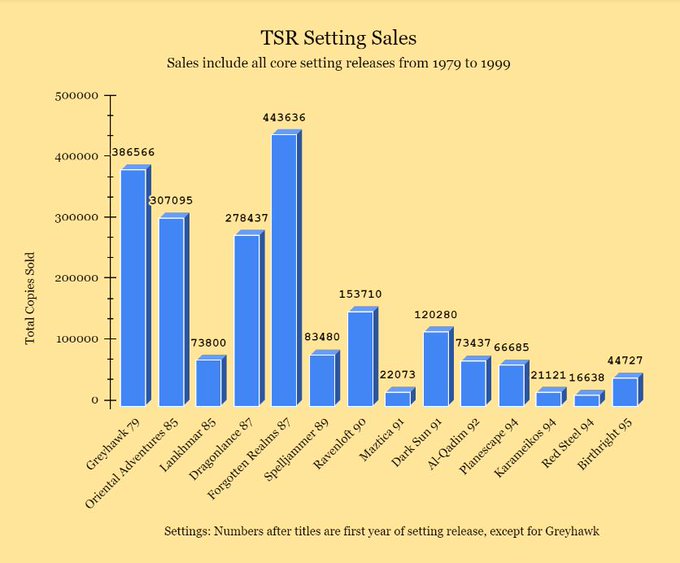Alzrius
The EN World kitten
~Nerd voice~I6 was a Hammer Horror spoof. The first (and only) true Ravenloft publication was I7, The House on Griffin Hill.
Akshullee, Ravenloft II: The House on Gryphon Hill was I10. I7 was Baltron's Beacon.
~Nerd voice~I6 was a Hammer Horror spoof. The first (and only) true Ravenloft publication was I7, The House on Griffin Hill.
I'm guessing that VRGtR didn't do too well either, just based on my seeing it put on a fire sale for 70% off 18 months after its release and seeing stacks and stacks of it unsold on game store shelves. And Ravenloft was one of their bestselling product lines during that era. And Curse of Strahd is one of the highest regarded 5e adventures.I think 5e adventure settings always risk suffering in comparison to 2e antecedents. This is by design: after they bought TSR, WotC did a forensic analysis of TSR's finances and discovered that all those 2e settings were an albatross for the company. They each became their own game within the game, fragmenting the player base and making it so that almost all of them lost money, despite being beautiful and richly developed. So now WotC tries to keep settings from feeling exclusive from the rest of the game, which tends to make them more generic, and also means that WotC seldom release follow-up books exclusive to a particular setting.
The Dark Powers checks were fairly arbitrary and rare. The PC commit bloody murder dozens of times and the dice don't care, but this one time the PC steals an apple and that's what gets the DP's attention, because the DM rolled a 3 or less on a d100? Nah. It's actually more appropriate and more fun for the DM to decide when the DPs take notice, or to work it out with the player. I'm doing that now--I've even discussed with the player what they might turn into, if they keep playing their character in an evil-ish way. Curses from the Dark Powers are a powerful roleplaying tool if they aren't left to random chance.
Just a bit of context; if "that era" was AD&D 2nd Edition, then Ravenloft's campaign setting debut did indeed put other 2E campaign settings to shame, even if it never reached the heights of its 1E counterparts. To use a photo from Ben Riggs' twitter feed:And Ravenloft was one of their bestselling product lines during that era.

What exemplifies the general lack of attention and care in the book are the map scales. Granted, this is something I could change easily, but it shows a bizarre absence of understanding of a world.
Most of these domains are tiny, unrealistically so.
- The "vast deserts" of Har'Akir is 25 miles across. A party can cross the desert in two days.
- The zombie ravaged domain of Falkovnia is 15 miles across - with mountain ranges spanning 5 miles.
- The magical wasteland of Hazlan has features separated by 2 miles (a 30 minute trek), where magically-corrupted purple worms slither.
- Lamordia's Sleeping Beast mountain range "stretches for miles" - 18 miles to be exact.
Here's what it looks like after joining the Amber Wastes cluster (from Domains of Dread):Again, not weighing on the book, as I haven't read it, but that map scale actually sounds pretty close to the original black box scale (which was 1 inch equalled ten miles). Ravenlof was originally quite small compared to other settings and also designed to have much lower population levels than other settings. Har'Akir I think is about that size give or take in most of 2E Ravenloft (I am just eyeballing it looking at the map so possible I am not 100% spot on here).

Here's what it looks like after joining the Amber Wastes cluster (from Domains of Dread):

I'll take your word on that. I have the red box (which I think is the revised version from 2E), and its scale is 1 inch = 100 miles.Again, not weighing on the book, as I haven't read it, but that map scale actually sounds pretty close to the original black box scale (which was 1 inch equalled ten miles). Ravenlof was originally quite small compared to other settings and also designed to have much lower population levels than other settings. Har'Akir I think is about that size give or take in most of 2E Ravenloft (I am just eyeballing it looking at the map so possible I am not 100% spot on here). It is a little hard to be precise looking at the PDF (I have the box on my shelf but don't feel like taking it down). But I would say the Sleeping Beast in the Black Box looks to be roughly 25 miles in length (but it is unevenly shaped so that length could be less depending on where you measure from).
I'll take your word on that. I have the red box (which I think is the revised version from 2E), and its scale is 1 inch = 100 miles.
The map in that one shows the Sleeping Beast mountains as about 150 miles and Falkovnia being 350 miles across (hardly able to be crossed within a day).
I think that these distances are more effective at conveying a sense of isolation and dread.
